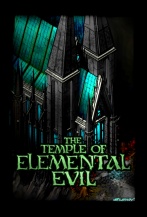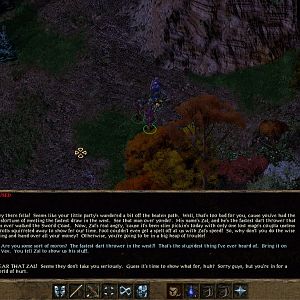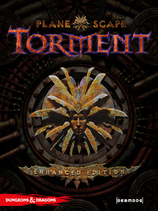-

- Forums
- Chatrooms
- Gallery
- Gameplay Videos
- Upload
- Articles
- Mod Reviews
- Shop SP: Games, Movies, Books

| The
Temple of Elemental Evil Introduction |
Where does The Temple of Elemental Evil originate?
 At
first glance, Hommlet seems like many another village. It lies nestled
within the Kron Hills, 10 leagues south of the city of Verbobonc, somewhat
east of the Lortmil Mountains and just west of the Gnarley Forest. This
region is peaceful, fertile countryside suited to such pursuits as farming,
herding, woodcutting, hunting and trapping, so it was only natural that
a prosperous little settlement should arise, located on a crossroads leading
to the Wild Coast. Alas, many sinister characters and vile creatures were
drawn there too, establishing a nearby community called Nulb. In this
iniquitous place, a chapel was erected, one dedicated to vice, damnation
and the worship of various immoral and malevolent deities. Over time,
as more loathsome beings came to visit, it grew into the Temple of Elemental
Evil, filled with dark priests and their corrupted servants.
At
first glance, Hommlet seems like many another village. It lies nestled
within the Kron Hills, 10 leagues south of the city of Verbobonc, somewhat
east of the Lortmil Mountains and just west of the Gnarley Forest. This
region is peaceful, fertile countryside suited to such pursuits as farming,
herding, woodcutting, hunting and trapping, so it was only natural that
a prosperous little settlement should arise, located on a crossroads leading
to the Wild Coast. Alas, many sinister characters and vile creatures were
drawn there too, establishing a nearby community called Nulb. In this
iniquitous place, a chapel was erected, one dedicated to vice, damnation
and the worship of various immoral and malevolent deities. Over time,
as more loathsome beings came to visit, it grew into the Temple of Elemental
Evil, filled with dark priests and their corrupted servants.
This was the setting for the very first module within the pen and paper Greyhawk campaign, which was introduced with the release of the Advanced Dungeons & Dragons rule set in 1985. Now, it is serving as the backdrop for Greyhawk: The Temple of Elemental Evil, a 3e D&D CRPG being developed by Troika Games and targeted for release later this year.
What is Greyhawk?
Greyhawk was the first commercial campaign that TSR made. It was Gary Gygax's world, and it consists primarily of various countries of the Flanaess, the civilized part of the continent of Oerik on the planet Oerth. The Greyhawk campaign has a nice big feel to it, and while it has powerful magic and artifacts, it doesn't feel quite as magic-rich as the Forgotten Realms or Planescape. The history of Greyhawk is rich and varied, and the world itself goes through quite a bit of change over time. ToEE is set just before the Greyhawk Wars begin, which really change a lot of the politics of the campaign.
Short Story Synopsis
The backstory, in brief, is that 10 years ago, an evil temple began pillaging the countryside, and the forces of good showed up and there was a great battle. Evil lost, the temple was sealed up, and the good guys went home. That would have been the end of things, except now evil seems to be stirring again. It's nothing definite, nothing you can put your finger on, but people have disappeared, and there seem to be more bandits than usual, and people have reported seeing... things. Eventually, your group comes to the area to investigate. However, why a particular player party comes to the area is dependent on their alignment.
Story from the official website:
Long ago, in the land of Flanaess,
an evil demoness founded a cult dedicated to exploring evil in its most elemental forms. This cult was based in a temple just outside the village of Hommlet in a vile shire known as Nulb. Soon, this cult ruled the region with tyranny; times of chaos and violence ensued. Hard-fought battles were waged and the war was eventually won by the good armies of nearby lands. The temple was razed, the villains were imprisoned, and order was restored. The temple itself faded into distant memory...until now.
Recently, bandits have begun patrolling the roads outside Hommlet and wicked forces are rumored to be afoot, converging on the ruined temple at Nulb. Their purposes for such meetings are as yet unknown. The identity of these people are equally a mystery. Some claim they are bent on slaying monsters and maintaining order within the region, but no one can be sure.
So begins your adventure within the Realm of Greyhawk. It is an adventure that will lead to the source of a deep and abiding mystery, to the very core of evil itself.
Features
- Faithful incorporation of D&D 3.5 edition rules based on the classic module by Gary Gygax
- Create up to five characters in your party, and gain up to three followers and familiars
- Dozens of skills and class abilities, over 50 feats and hundreds of spells to chose from, including cleric domain spells
- Over a hundred different monsters, from goblins and hill giants to elementals and demons
- Hundreds of NPC's, each with dialog and reactions to player behavior
- Dozens of potential followers, each with their own goals and agenda
- Multiple solutions to quests, including many that use dialog skills to allow non-combative options
- More than 50 sidequests invite the player to explore away from the main storyline
- Multiple starting points depending on your party's alignment and multiple end games depending on how you play the game
Ability Score Generation
The rolling system is in, and as long as you're not in Ironman mode you get as many rolls as you want (but they are kept track of so you can't brag to your friends). They are also implementing a point buy system that defaults to 25 points.
Party Composition
You can have five player characters in the party, and you have full control over these characters. You can also have up to three followers, which are NPC’s that join the party. These characters are controllable in that you move them about and direct them in combat, but they have their own inventories and will take their own share of loot. Finally, you can have up to five more uncontrollable followers, which are creatures like animal companions or summoned monsters, which simply follow your character and attack whatever you attack.
Implementation of Magic
Troika is implementing a few hundred spells of levels 0 through 5. The coolest thing about the magic system is the target system for spells. You can actually see the area of effect of any spell in the game. When you throw a Fireball, for instance, you are given a circle that you can move around the screen, and any target within the circle gets highlighted. ToEE supports spells that can have multiple targets, like Magic Missile, and even ones with variable size areas of effect, like Wall of Fire. These features make combat magic feel very strategic.
How will alignment play a part in the game?
There are two kinds of alignment in the game. The first kind is the standard D&D concept of character alignment. Each character picks one of the nine alignments, and this determines the character's outlook on life. We check for this alignment in dialogs, to give special choices to particularly aligned characters, and with aligned magic items, especially weapons, to determine how effectively the character can use it.
The second kind of alignment is party alignment. Party alignment is your way of telling the game what kind of characters you are making and how you intend to act. The game reacts to party alignment by changing the starting location of the game, which gives your party its reason for adventuring, and by changing dialog options and storylines in the game. The game has several possible endings, some of which are restricted to certain party alignments.
Your selection of party alignment will also restrict what alignments of characters you can add to your party. You can only pick character alignments that are at most one step away from the party alignment. For example, if you select "True Neutral" as your party alignment, then the five alignments of "True Neutral", "Neutral Good, "Lawful Neutral", "Neutral Evil" and "Chaotic Neutral" are highlighted, which means you can add characters of those five alignments to your party. Note that some party alignments preclude certain classes with alignment restrictions. For example, monks cannot be in any chaotically aligned parties because their alignment must be lawful, and paladins cannot be in any evil or chaotic parties. In fact, paladins provide an additional restriction in that they will never group with an evil character. So even though a "Lawful Neutral" party could contain Lawful Good and Lawful Evil characters, such a party cannot contain both a paladin and a Lawful Evil character. Once one such character is added to the party, the other is prohibited.
System Requirements
Minimum:
Operating System: Windows 98/ME/2000/XP
Processor: Pentium® III 700 MHz
Memory: 128 MB
Hard Disk Space: 1200 MB Free
CD-ROM Drive: 4x
Video: 16 MB Windows 98/ME/2000/XP - compatible 3D video card
Sound: Windows 98/2000/ME/XP compliant soundcard
DirectX: DirectX® version 9.0 (included) or higher
Peripherals: Keyboard, Mouse
Recommended:
Operating System: Windows 98/ME/2000/XP
Processor: Pentium® 4 1.7 GHz or higher
Memory: 256 MB
Hard Disk Space: 1.2 GB
CD-ROM Drive: 10x speed
Video: 64 MB Windows 98/Me/2000/XP-compatible 3D video card
Sound: Windows 98/2000/ME/XP DirectX® certified sound card
DirectX: DirectX® version 9.0 (included) or higher
Peripherals: Keyboard, Mouse
Projected Release Date
The game has gone gold on September 5, 2003. Here is the official press release:
ATARI'S THE TEMPLE OF ELEMENTAL EVIL GOES GOLD
Popular Dungeons & Dragons World of Greyhawk to Make First Interactive Appearance on September 23
LOS ANGELES - Sept. 5, 2003 - Atari and Troika Games are pleased to announce that development is complete on The Temple of Elemental Evil for PC CD-ROM. Published by Wizards of the Coast, the World of Greyhawk, remains one of the most popular Dungeons & Dragons(r) campaign settings of all time and will make its first interactive appearance with the September 23rd release of The Temple of Elemental Evil. The Temple of Elemental Evil will feature an exciting party-based single player campaign, an engaging storyline based on the classic D&D(r) adventure of the same name as well as a faithful translation of the latest 3.5 edition rules.
The U.S. launch of the game to retail outlets nationwide will occur on September 23, 2003. For more information about The Temple of Elemental Evil, visit www.greyhawkgame.com.
A few days later, the US release date was pushed another week back, to September 16.
Who is working on ToEE?
Tim Cain
- lead designer and project leader
Michael McCarthy - lead artist
Steve Moret - lead programmer
Tom Decker - producer and designer
Peter Delgado - level artist
Lucas Feld - level artist
Chris Glenn - concept artist
Corey Pelton - animator
Craig Matchett - modeler
Bryan Warmack - level layout
Lee Needham - rendering and optimization
Sean Craig - core d20 implementation
Aaron Brunstetter - interface and d20 implementation
Huy Nguyen - interface and magic system
14 team members in all, of whom the first three also worked on Arcanum, and Tim Cain on Fallout as well.


